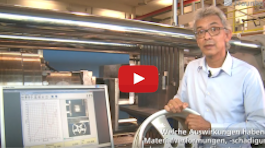Fatigue Behavior and Fracture Mechanics
Load-bearing components and structures in all industrial sectors such as automotive, vehicle, railway, aerospace, steel and bridge constructions are exposed to complex stresses. Many technical cases of damage can be attributed to material fatigue due to cyclic mechanical loading. In order to ensure the reliable use of critical components, the assessment of material fatigue is of decisive importance.
On the basis of our material and damage models for components and structures subjected to fatigue loading, we perform reliable service lifetime calculations so our customers are able to fully benefit from the potential of the strength reserves of their construction materials under extreme loads.


Modern Fracture Mechanics
For the design and assessment of safety-relevant components, fracture mechanics methodologies are state-of-the-art. In the presence of crack-like defects (detected or postulated), the methods of fracture mechanics provide information about the fitness of purpose of components, the remaining service life and the safety regarding an uncontrolled crack growth. Well-founded decisions about commissioning, lifetime extension, periodic inspections or the exchange of a component can be provided on this basis. Typical industrial areas for the application of fracture mechanics are:
- Aerospace
- Plant construction
- Pressure vessels and piping systems of power plants
- Gas and steam turbines
- Pipelines
- Railway vehicles
- Steel structures, i.e. for crane and bridge construction
- Welded components
We support our customers with our competencies in material testing, numerical simulation, analytical failure assessment and failure analysis related to fracture mechanics questions. Together with our customers, we develop solutions for the assessment of the safety and the remaining service lifetime of machines and plants, the extension of their service lifetime, the determination of inspection intervals, the design optimization and a safety-related material selection. Moreover, we offer support for the preparation of expert reports and represent investigation results before technical regulatory authorities.
Contact us! Together we'll find a customized solution for the challenges you face.
IWM VERB is a software tool which is used for the assessment of components with crack-like defects. The numerical basis of the software consists of elastic and elastic-plastic fracture mechanics methods and solutions, which are in accordance with internationally accepted guidelines and recommendations. Its application mainly refers to metallic components that are statically and cyclically loaded. However, non-metallic materials can also be assessed as long as their behavior can be described with common fracture mechanics concepts.
The failure assessment software IWM VERB is applied by many companies around the world to solve their specific fracture mechanics issues. Therefore, the development and adaptation of the software is accomplished in close collaboration with the client. Moreover, we offer training courses for the efficient application of fracture mechanics methods.
Our portfolio ranges from materials characterization to safety evaluation and lifetime assessment of components with defects.
- Material qualification
- Microstructure and failure analysis
- Numerical and experimental stress and strain analysis of components under static and cyclic loading
- Numerical component assessment under static and cyclic loading experimentally supported by component tests
- Numerical and experimental strength and safety analysis
- Welding simulation and strength analysis of welded joints under consideration of residual stress and distortion
- Numerical simulation of shot-peening, deep rolling and high frequency mechanical impact and resulting residual compressive stresses in the surface-near layer of metallic structural materials
- Calculation of service lifetime of mechanical surface-treated (such as shot-peened, deep rolled and high frequency mechanical impact) components including the quantification of the lifetime improvement and the estimation of the cost-benefit ratio
Experimental determination of fracture mechanics parameters:
- Fracture toughness, crack resistance curves, fatigue crack growth curves
- Crack resistance tests in a temperature range of about -196 °C to 600 °C in compliance with test standards such as ASTM E399, E1820, E1921, E647
- Non-standardized tests under custom specified conditions or with non-standard specimen geometries
Stress analyses:
- Of specimens and components with cracks or other defects
- Under complex thermo-mechanical constraints
- Using state-of-the-art and advanced material models
- With consideration of elastic-plastic deformation, creep and progressing damage
- Under static and cyclic loading
- Considering welding stresses
Fracture mechanics assessment:
- In accordance with specific standards such as R6, SINTAP, FITNET, BS 7910, API 579 or FKM guideline
- Using special software, for example, IWM VERB or ERWIN
- Including custom-specific software implementation (component and crack geometry, stress conditions, material properties)
- Using deterministic and probabilistic methods
Furthermore, we develop advanced solutions and evaluation concepts and consistently implement them into our calculation programs and the FKM guideline "Fracture mechanics strength assessment" co-developed by us (FKM = Forschungskuratorium Maschinenbau).
- Electromechanical, servo-hydraulic and resonance testing machines (N to MN) to carry out static and cyclic material and component tests
- Multi-axial loading devices (tension-torsion; span) for multiaxial component testing
- Air-conditioned shock and vibrations tests
- Metallography and fracture surface analysis
- Equipment to perform fracture mechanical tests (i.e. ASTM E399, E1820, E1921 and E647) over large force and temperature ranges
- Determination of strains by use of clip-gauges or digital image correlation (DIC) for areal strain measurements
 Fraunhofer Institute for Mechanics of Materials IWM
Fraunhofer Institute for Mechanics of Materials IWM





